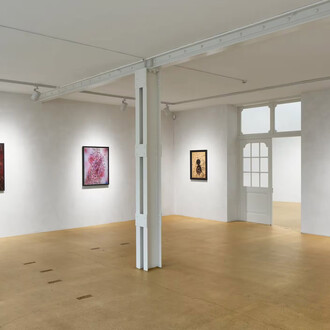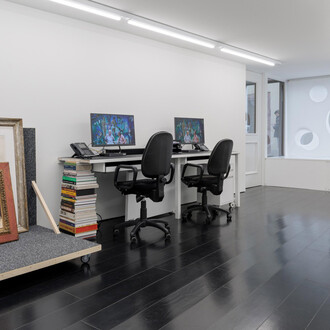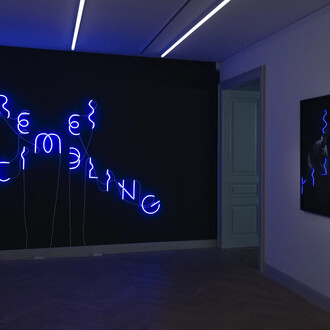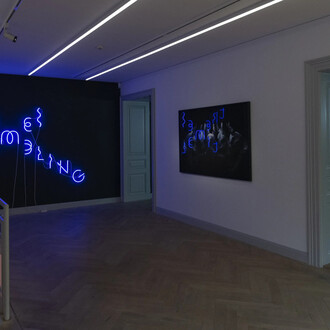“What is your name?”; “What is your occupation?”; “What is your motivation on a scale from personal gain-driven to impact-driven?” These seemingly simple questions are the entry point into Humanities, Neïl Beloufa’s first institutional solo exhibition in Switzerland at Kunsthalle Basel. However, it soon becomes clear that the aim is not to collect psychographic and narrative data. With each answer, visitors build their own digital avatar, guiding them through a nuanced process of self-definition and introspection. Beloufa crafts a complex network of digital and physical spaces where narratives unfold, turning the exhibition into an immersive experience shaped by the visitors themselves. Yet, a critical issue emerges: Who is truly in control?
At the heart of the exhibition are the three major installations—Growth, 2024, Tombstone, 2024, and Global Agreement, 2019—which together interrogate how personal narratives, societal structures, and symbols of success and failure guide our understanding of ourselves and the world. In these works, Beloufa investigates the tension between individual agency and the broader systems that govern our perception. Throughout the exhibition, new and older pieces from series such as Applique (sconce), 2019, Double Standard, or ATM and themes, both 2024, extend along the walls, both complementing the central installations and creating connections among them. By framing the landscape, these works not only expand on the themes raised by the core pieces but also draw visitors deeper into an aesthetic world expressed through gaming-inspired forms and the language of digital imagery.
Growth immerses visitors in an interactive environment that blurs the line between individual and collective narratives. As they move through various stations, participants craft their own personal success stories, making choices that engage with topics of technology, ecology, health, and society. Beginning with a check-in process that positions each visitor as the protagonist of their own story, the installation creates a gamified environment where every decision impacts the trajectory of their narrative.
The installation includes over forty carved PU foam objects arranged on the wall and scattered tables, each humorously representing elements tied to technology, history, pop culture, or iconic symbols. For Basel, the collection features Swiss cultural icons such as Toblerone chocolate, the Swiss Army knife, and the mountain flower Edelweiss. Visitors are prompted to intuitively select objects they find valuable, with each choice subtly shaping their personalized avatar. These quick, seemingly effortless selections—reminiscent of instant social media interactions—capture insights that feeds into each participant’s evolving narrative. The work points to the absurdity of the value assigned to these symbols, questioning not only how we define success but also the systems that celebrate and then discard it.
This probe of societal structures continues with Tombstone, a kinetic sculpture that addresses the fragile nature of success. Drawing inspiration from the world of finance and banking, Beloufa uses “financial tombstones”—small plexiglass plaques commemorating successful financial transactions— as his primary material. Their name stems from the rectangular shape of a gravestone. Typically displayed in the offices of brokers and underwriters, they function as markers of achievement. In the exhibition, the artist places the trophies on a conveyor belt that slowly moves them toward a custom-built press, where they are ultimately destroyed. This intermittent mechanical choreography of decay underscores the transience of fame and recognition. The gradual advance of the trophies becomes a metaphor for the disconnect between their symbolic value and material fragility.
In contrast to the corporate and financial symbols of success, Global Agreement shifts the focus to the human side of global power structures, specifically the military. Instead of the sensationalized imagery of conflict often amplified by news outlets and online media, the artist turns his attention to the personal stories of individuals who have chosen a path in the military. Phone or webcam recordings are displayed on large monitors mounted on gymlike or computer-gaming seating structures. Seated within the sculpture, face-to-face with the protagonists, viewers are transformed from distant observers into active participants in an increasingly authentic social interaction, evoking a conversational dynamic that oscillates between anonymity and intimate confession. These dialogues reveal how soldiers construct their sense of self within highly regulated and structured environments, offering an intimate glimpse of the human element behind the uniforms. By centering on subjective narratives rather than abstract geopolitical concepts, Beloufa challenges viewers to consider the complex interplay between individual agency and the larger forces that define their roles, emphasizing the tension between personal identity and institutional power.
At the conclusion of the exhibition journey, visitors scan their codes at a terminal in the final room, triggering the projection of a personalized short film generated by an AI system. What unfolds is a disquieting avatar—a digital figure animated using the visitor’s submitted photograph—delivering a surreal monologue that obscures the boundaries between cynicism and reality. This final presentation of Growth expands upon the scenarios visitors encountered earlier, where they may have launched a company, established a cult, or founded a political party—now revealing uncanny parallels among these seemingly unrelated activities. The film blends self-help jargon, corporate buzzwords, and a touch of absurdity, reflecting and amplifying the choices made along the way. Much like online content consumed without full context, these films offer a vast range of interpretive possibilities, highlighting the ambiguous nature of digital communication and how easily information can be distorted or misunderstood.
Beloufa’s ability to weave together diverse discourses— personal success, institutional critique, and the commodification of identity—creates a cohesive yet multifaceted portrait of contemporary society. Distinctions between observer and observed, triumph and defeat, virtual and tangible merge, creating an intricate web of self-reflection, challenging our perceptions of reality and identity. The systems that structure our society are exposed as fragile constructs. Yet within this fragility lies a liberating realization: if everything can be so easily deconstructed, unforeseen possibilities for reconstruction can emerge. In the end, more questions than answers remain, but this is the work’s greatest strength. It reminds us that in a world driven by algorithms and prefabricated narratives, the ability to think critically and self-reflect remains our most valuable asset—an invitation to explore and embrace our humanity in all its complexity and contradiction.
















